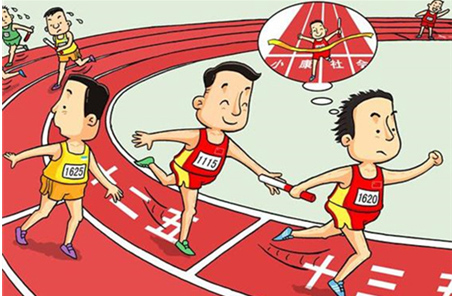【署名文章】李克強(qiáng)總理:中國經(jīng)濟(jì)的藍(lán)圖(中英對(duì)照)
發(fā)布人員:網(wǎng)站管理員 新聞來源:互聯(lián)網(wǎng) 發(fā)布日期:2016-02-27 10:52:14
摘要: 本文發(fā)表于《經(jīng)濟(jì)學(xué)人》年刊《世界2016》
來源:英語巴士 編輯:福建泉州啟航翻譯公司

中國經(jīng)濟(jì)的藍(lán)圖
China’s Economic Blueprint
李克強(qiáng) Li Keqiang
2016年,中國將繼續(xù)深化改革,擴(kuò)大對(duì)外開放,拓展國際經(jīng)濟(jì)合作。對(duì)于長(zhǎng)期觀察中國的人們來說, 這些聽起來大概耳熟能詳。改革、開放與國際合作的有力結(jié)合,是多年來中國增長(zhǎng)故事的核心要素。我們正在將其進(jìn)一步推向前進(jìn)。
For the Chinese economy, 2016 is a year of reform, openness and international co-operation. These priorities may sound surprisingly familiar to China-watchers. Their potent combination has been instrumental in China’s growth story over decades. We are taking them further.
中國經(jīng)濟(jì)總量已超過10萬億美元。在這樣的體量基礎(chǔ)上繼續(xù)發(fā)展,過度依賴投資和出口拉動(dòng)是不可持續(xù)的。小修小補(bǔ)只能應(yīng)付一時(shí):本屆政府沒有推行量化寬松,也沒有采取競(jìng)爭(zhēng)性貨幣貶值的措施,我們作出了推動(dòng)結(jié)構(gòu)性改革的抉擇。
Given the size of China’s $10 trillion economy, overdependence on investment and exports is not tenable. What is called for is not temporary fixes: my government has resisted the temptations of quantitative easing and competitive currency devaluation. Instead, we choose structural reform.
我們要通過大力推動(dòng)市場(chǎng)化改革,盡快構(gòu)建起一個(gè)大幅度增加創(chuàng)新驅(qū)動(dòng)和消費(fèi)拉動(dòng)力的可持續(xù)增長(zhǎng)新模式,更加關(guān)注社會(huì)就業(yè)、居民收入增長(zhǎng)和生態(tài)環(huán)境的持續(xù)改善。
We are pushing through market reforms, to speed the transition to a sustainable growth model markedly more driven by innovation and consumption. Employment, income levels and the environment are all high on our list of priorities.
我們將很多政策工具組合成兩大經(jīng)濟(jì)增長(zhǎng)引擎,一個(gè)是大眾創(chuàng)業(yè)、萬眾創(chuàng)新,這是結(jié)構(gòu)性改革的重要內(nèi)容;另一個(gè)是增加公共產(chǎn)品、公共服務(wù)供給,既拉動(dòng)有效需求,又可以改善民生。這兩者的關(guān)鍵在于處理好政府和市場(chǎng)的關(guān)系,為個(gè)人、中小企業(yè)和大企業(yè)等市場(chǎng)主體營造更加適于創(chuàng)業(yè)創(chuàng)新的環(huán)境,釋放增長(zhǎng)潛力。一個(gè)更加簡(jiǎn)政放權(quán)的政府可以運(yùn)用自身所長(zhǎng),做好宏觀經(jīng)濟(jì)調(diào)控者、公平競(jìng)爭(zhēng)的有效監(jiān)督者、改革的推動(dòng)者,并在系統(tǒng)性風(fēng)險(xiǎn)冒頭時(shí)果斷加以應(yīng)對(duì)。
We are combining myriad policy tools into two major drivers of growth. The first, essential to structural reform, highlights entrepreneurship and innovation. The second focuses on better provision of public goods and services-which in turn contributes to stronger demand and a higher quality of life.
It is all about striking a better balance between the state and the market by offering individuals, small and medium-sized companies as well as major corporations a more enabling environment for business development and innovation, thereby unlocking growth potential. A leaner government can play a better role as macroeconomic fine-tuner, regulator for fair competition, champion of the reform agenda and ultimate backstop when systemic risks threaten.
這些改革努力正在收到成效。服務(wù)業(yè)已占到中國GDP的一半,實(shí)現(xiàn)對(duì)制造業(yè)的反超且升勢(shì)不減。創(chuàng)業(yè)創(chuàng)新蔚然成風(fēng),每天新增注冊(cè)企業(yè)超過1萬家。高技術(shù)產(chǎn)業(yè)增速明顯快于整個(gè)工業(yè),新技術(shù)、新的商業(yè)模式和管理方式正在以過去難以想象的方式拓寬中國經(jīng)濟(jì)的地平線。
These efforts are already paying off. The services sector, accounting for half of China’s GDP, keeps widening its lead over manufacturing. Entrepreneurship and innovation are the new fashion. Over 10,000 new businesses are registered every day. Growth in high-tech industries is leading that of the industrial sector by a wide margin. Innovations in technology, business models and management keep widening the economic horizon in previously unimaginable ways.
中國每年新增城鎮(zhèn)就業(yè)1000萬人以上,居民收入增長(zhǎng)超過GDP增速。消費(fèi)對(duì)經(jīng)濟(jì)增長(zhǎng)的貢獻(xiàn)率達(dá)到 60%,消費(fèi)升級(jí)也伴隨著強(qiáng)勁增長(zhǎng)。以出境游為例,去年中國公民出境達(dá)1億人次,今年上半年又同比增長(zhǎng)10%。
We are creating over 10 million jobs a year and disposable-income growth is outstripping that of GDP. Consumption, already responsible for 60% of growth, keeps going strong and up-market. Take outbound tourism, for example: Chinese citizens made over 100m trips overseas in 2014, and the first half of 2015 saw year-on-year growth of 10%.
簡(jiǎn)而言之,盡管增速有所放緩,中國經(jīng)濟(jì)正在朝著我們期待的方向,朝著更多立足內(nèi)需和創(chuàng)新拉動(dòng)的方向發(fā)展。一個(gè)副產(chǎn)品是,經(jīng)濟(jì)運(yùn)行狀況同用電量、鐵路貨運(yùn)量和新增銀行貸款等衡量指標(biāo)之間的關(guān)聯(lián)系數(shù)在發(fā)生著變化。中國經(jīng)濟(jì)從“求快求大”到“求優(yōu)求精”的轉(zhuǎn)變是一件好事。不然我要開始擔(dān)心各項(xiàng)改革措施是否真的取得成效了。
In short, despite moderation in growth, the Chinese economy is moving in the desired direction of stronger domestic demand and innovation. One by-product is a fall in the relevance of indicators such as power consumption, rail-cargo volume and new bank credit in gauging economic performance. Yet this transition from “bigger is better” to “l(fā)ess is more” is a good thing. I would otherwise be worried whether the reforms were working as intended.
結(jié)構(gòu)性改革不僅是尋找新的增長(zhǎng)點(diǎn),也包括提高傳統(tǒng)產(chǎn)業(yè)的競(jìng)爭(zhēng)力。中國規(guī)模龐大的工業(yè)部門仍是我們?cè)鲩L(zhǎng)規(guī)劃的重要組成部分。我們正在努力推動(dòng)“中國制造”更上層樓,提出了“中國制造2025”、“互聯(lián)網(wǎng)+”等舉措。我們也將更大程度融入世界經(jīng)濟(jì),在更多領(lǐng)域放寬外資準(zhǔn)入,其中服務(wù)業(yè)領(lǐng)域的開放也會(huì)進(jìn)一步擴(kuò)大。
Structural reform is not only about exploring new sources of growth, but also about making traditional industries more competitive. China’s massive industrial sector remains a vital part of our plan for growth. We are working on upgrading “Made in China” with “China Manufacturing 2025”, “Internet Plus” and other initiatives. We are deepening integration with the world economy with deregulation in many areas to improve access for foreign investments, not least in service sectors.
當(dāng)然,隨著中國市場(chǎng)不斷成熟,競(jìng)爭(zhēng)也會(huì)愈發(fā)激烈。但我們有信心,因?yàn)橹袊袌?chǎng)值得投入,因?yàn)橹袊侨蚬?yīng)鏈的重要樞紐,而且中國還可以成為同各國合作開發(fā)全球市場(chǎng)的理想伙伴。
Make no mistake. Competition is growing tougher as the Chinese market matures. But we are confident that China is a worthwhile market, a pivot of the global supply chain and a partner for the wider world market.
集各方所長(zhǎng)
The best of all worlds
我們的世界難稱富足。生活在廣大發(fā)展中國家的數(shù)十億人民還沒有享受到大規(guī)模工業(yè)化和良好基礎(chǔ)設(shè)施的便利。他們的需求是巨大的,但由于缺乏資金和負(fù)擔(dān)得起的裝備和技術(shù),這些需求很大程度上被抑制了。
This is not yet a world of plenty. Billions in developing countries are yet to benefit from large-scale industrialisation and proper infrastructure. The demand is enormous, but largely subdued for lack of proper funding, affordable equipment and technology.
這是可以改變的。中國正在推動(dòng)“一帶一路”建設(shè)。通過國際產(chǎn)能合作,將中國制造業(yè)的性價(jià)比優(yōu)勢(shì)同發(fā)達(dá)經(jīng)濟(jì)體的高端技術(shù)相結(jié)合,向廣大發(fā)展中國家提供“優(yōu)質(zhì)優(yōu)價(jià)”的裝備,幫助他們加速工業(yè)化、城鎮(zhèn)化進(jìn)程,以供給創(chuàng)新推動(dòng)強(qiáng)勁增長(zhǎng)。試想如果中國13億人的發(fā)展能為支撐世界經(jīng)濟(jì)增長(zhǎng)作貢獻(xiàn),那涉及數(shù)十億人的增長(zhǎng)將為大宗商品市場(chǎng)、制造業(yè)以及更廣泛的領(lǐng)域等帶來多么巨大的機(jī)遇!
This can be changed. On connectivity, we have the “Belt and Road” initiative. On industrialisation and urbanisation, we offer partnerships in industrial-capacity co-operation. Combining China’s manufacturing prowess with the cutting-edge technologies of the developed economies, we can, together, supply good equipment at good prices to the developing world, sustaining robust growth with supply-side innovation. If development for 1.3 billion Chinese has helped buoy world growth, imagine what such growth spurts for many more billions could do for the commodities market, manufacturing and many others.
2016年以及之后的更長(zhǎng)時(shí)期,推動(dòng)大眾創(chuàng)業(yè)、萬眾創(chuàng)新等結(jié)構(gòu)性改革和更高水平對(duì)外開放、各方共贏的國際合作都將是我們工作的重點(diǎn)。這是我們對(duì)實(shí)現(xiàn)可持續(xù)和高質(zhì)量增長(zhǎng)的答案,是一份中國市場(chǎng)、中國創(chuàng)造與世界共享的藍(lán)圖。
Structural reform featuring entrepreneurship and innovation, greater openness and win-win international co-operation – these are our priorities for 2016 and beyond. This is our answer to the call for sustainable growth – a blueprint for sharing with the world China’s market opportunities and Chinese ingenuity.
來源:英語巴士 編輯:福建泉州啟航翻譯公司

中國經(jīng)濟(jì)的藍(lán)圖
China’s Economic Blueprint
李克強(qiáng) Li Keqiang
2016年,中國將繼續(xù)深化改革,擴(kuò)大對(duì)外開放,拓展國際經(jīng)濟(jì)合作。對(duì)于長(zhǎng)期觀察中國的人們來說, 這些聽起來大概耳熟能詳。改革、開放與國際合作的有力結(jié)合,是多年來中國增長(zhǎng)故事的核心要素。我們正在將其進(jìn)一步推向前進(jìn)。
For the Chinese economy, 2016 is a year of reform, openness and international co-operation. These priorities may sound surprisingly familiar to China-watchers. Their potent combination has been instrumental in China’s growth story over decades. We are taking them further.
中國經(jīng)濟(jì)總量已超過10萬億美元。在這樣的體量基礎(chǔ)上繼續(xù)發(fā)展,過度依賴投資和出口拉動(dòng)是不可持續(xù)的。小修小補(bǔ)只能應(yīng)付一時(shí):本屆政府沒有推行量化寬松,也沒有采取競(jìng)爭(zhēng)性貨幣貶值的措施,我們作出了推動(dòng)結(jié)構(gòu)性改革的抉擇。
Given the size of China’s $10 trillion economy, overdependence on investment and exports is not tenable. What is called for is not temporary fixes: my government has resisted the temptations of quantitative easing and competitive currency devaluation. Instead, we choose structural reform.
我們要通過大力推動(dòng)市場(chǎng)化改革,盡快構(gòu)建起一個(gè)大幅度增加創(chuàng)新驅(qū)動(dòng)和消費(fèi)拉動(dòng)力的可持續(xù)增長(zhǎng)新模式,更加關(guān)注社會(huì)就業(yè)、居民收入增長(zhǎng)和生態(tài)環(huán)境的持續(xù)改善。
We are pushing through market reforms, to speed the transition to a sustainable growth model markedly more driven by innovation and consumption. Employment, income levels and the environment are all high on our list of priorities.
我們將很多政策工具組合成兩大經(jīng)濟(jì)增長(zhǎng)引擎,一個(gè)是大眾創(chuàng)業(yè)、萬眾創(chuàng)新,這是結(jié)構(gòu)性改革的重要內(nèi)容;另一個(gè)是增加公共產(chǎn)品、公共服務(wù)供給,既拉動(dòng)有效需求,又可以改善民生。這兩者的關(guān)鍵在于處理好政府和市場(chǎng)的關(guān)系,為個(gè)人、中小企業(yè)和大企業(yè)等市場(chǎng)主體營造更加適于創(chuàng)業(yè)創(chuàng)新的環(huán)境,釋放增長(zhǎng)潛力。一個(gè)更加簡(jiǎn)政放權(quán)的政府可以運(yùn)用自身所長(zhǎng),做好宏觀經(jīng)濟(jì)調(diào)控者、公平競(jìng)爭(zhēng)的有效監(jiān)督者、改革的推動(dòng)者,并在系統(tǒng)性風(fēng)險(xiǎn)冒頭時(shí)果斷加以應(yīng)對(duì)。
We are combining myriad policy tools into two major drivers of growth. The first, essential to structural reform, highlights entrepreneurship and innovation. The second focuses on better provision of public goods and services-which in turn contributes to stronger demand and a higher quality of life.
It is all about striking a better balance between the state and the market by offering individuals, small and medium-sized companies as well as major corporations a more enabling environment for business development and innovation, thereby unlocking growth potential. A leaner government can play a better role as macroeconomic fine-tuner, regulator for fair competition, champion of the reform agenda and ultimate backstop when systemic risks threaten.
這些改革努力正在收到成效。服務(wù)業(yè)已占到中國GDP的一半,實(shí)現(xiàn)對(duì)制造業(yè)的反超且升勢(shì)不減。創(chuàng)業(yè)創(chuàng)新蔚然成風(fēng),每天新增注冊(cè)企業(yè)超過1萬家。高技術(shù)產(chǎn)業(yè)增速明顯快于整個(gè)工業(yè),新技術(shù)、新的商業(yè)模式和管理方式正在以過去難以想象的方式拓寬中國經(jīng)濟(jì)的地平線。
These efforts are already paying off. The services sector, accounting for half of China’s GDP, keeps widening its lead over manufacturing. Entrepreneurship and innovation are the new fashion. Over 10,000 new businesses are registered every day. Growth in high-tech industries is leading that of the industrial sector by a wide margin. Innovations in technology, business models and management keep widening the economic horizon in previously unimaginable ways.
中國每年新增城鎮(zhèn)就業(yè)1000萬人以上,居民收入增長(zhǎng)超過GDP增速。消費(fèi)對(duì)經(jīng)濟(jì)增長(zhǎng)的貢獻(xiàn)率達(dá)到 60%,消費(fèi)升級(jí)也伴隨著強(qiáng)勁增長(zhǎng)。以出境游為例,去年中國公民出境達(dá)1億人次,今年上半年又同比增長(zhǎng)10%。
We are creating over 10 million jobs a year and disposable-income growth is outstripping that of GDP. Consumption, already responsible for 60% of growth, keeps going strong and up-market. Take outbound tourism, for example: Chinese citizens made over 100m trips overseas in 2014, and the first half of 2015 saw year-on-year growth of 10%.
簡(jiǎn)而言之,盡管增速有所放緩,中國經(jīng)濟(jì)正在朝著我們期待的方向,朝著更多立足內(nèi)需和創(chuàng)新拉動(dòng)的方向發(fā)展。一個(gè)副產(chǎn)品是,經(jīng)濟(jì)運(yùn)行狀況同用電量、鐵路貨運(yùn)量和新增銀行貸款等衡量指標(biāo)之間的關(guān)聯(lián)系數(shù)在發(fā)生著變化。中國經(jīng)濟(jì)從“求快求大”到“求優(yōu)求精”的轉(zhuǎn)變是一件好事。不然我要開始擔(dān)心各項(xiàng)改革措施是否真的取得成效了。
In short, despite moderation in growth, the Chinese economy is moving in the desired direction of stronger domestic demand and innovation. One by-product is a fall in the relevance of indicators such as power consumption, rail-cargo volume and new bank credit in gauging economic performance. Yet this transition from “bigger is better” to “l(fā)ess is more” is a good thing. I would otherwise be worried whether the reforms were working as intended.
結(jié)構(gòu)性改革不僅是尋找新的增長(zhǎng)點(diǎn),也包括提高傳統(tǒng)產(chǎn)業(yè)的競(jìng)爭(zhēng)力。中國規(guī)模龐大的工業(yè)部門仍是我們?cè)鲩L(zhǎng)規(guī)劃的重要組成部分。我們正在努力推動(dòng)“中國制造”更上層樓,提出了“中國制造2025”、“互聯(lián)網(wǎng)+”等舉措。我們也將更大程度融入世界經(jīng)濟(jì),在更多領(lǐng)域放寬外資準(zhǔn)入,其中服務(wù)業(yè)領(lǐng)域的開放也會(huì)進(jìn)一步擴(kuò)大。
Structural reform is not only about exploring new sources of growth, but also about making traditional industries more competitive. China’s massive industrial sector remains a vital part of our plan for growth. We are working on upgrading “Made in China” with “China Manufacturing 2025”, “Internet Plus” and other initiatives. We are deepening integration with the world economy with deregulation in many areas to improve access for foreign investments, not least in service sectors.
當(dāng)然,隨著中國市場(chǎng)不斷成熟,競(jìng)爭(zhēng)也會(huì)愈發(fā)激烈。但我們有信心,因?yàn)橹袊袌?chǎng)值得投入,因?yàn)橹袊侨蚬?yīng)鏈的重要樞紐,而且中國還可以成為同各國合作開發(fā)全球市場(chǎng)的理想伙伴。
Make no mistake. Competition is growing tougher as the Chinese market matures. But we are confident that China is a worthwhile market, a pivot of the global supply chain and a partner for the wider world market.
集各方所長(zhǎng)
The best of all worlds
我們的世界難稱富足。生活在廣大發(fā)展中國家的數(shù)十億人民還沒有享受到大規(guī)模工業(yè)化和良好基礎(chǔ)設(shè)施的便利。他們的需求是巨大的,但由于缺乏資金和負(fù)擔(dān)得起的裝備和技術(shù),這些需求很大程度上被抑制了。
This is not yet a world of plenty. Billions in developing countries are yet to benefit from large-scale industrialisation and proper infrastructure. The demand is enormous, but largely subdued for lack of proper funding, affordable equipment and technology.
這是可以改變的。中國正在推動(dòng)“一帶一路”建設(shè)。通過國際產(chǎn)能合作,將中國制造業(yè)的性價(jià)比優(yōu)勢(shì)同發(fā)達(dá)經(jīng)濟(jì)體的高端技術(shù)相結(jié)合,向廣大發(fā)展中國家提供“優(yōu)質(zhì)優(yōu)價(jià)”的裝備,幫助他們加速工業(yè)化、城鎮(zhèn)化進(jìn)程,以供給創(chuàng)新推動(dòng)強(qiáng)勁增長(zhǎng)。試想如果中國13億人的發(fā)展能為支撐世界經(jīng)濟(jì)增長(zhǎng)作貢獻(xiàn),那涉及數(shù)十億人的增長(zhǎng)將為大宗商品市場(chǎng)、制造業(yè)以及更廣泛的領(lǐng)域等帶來多么巨大的機(jī)遇!
This can be changed. On connectivity, we have the “Belt and Road” initiative. On industrialisation and urbanisation, we offer partnerships in industrial-capacity co-operation. Combining China’s manufacturing prowess with the cutting-edge technologies of the developed economies, we can, together, supply good equipment at good prices to the developing world, sustaining robust growth with supply-side innovation. If development for 1.3 billion Chinese has helped buoy world growth, imagine what such growth spurts for many more billions could do for the commodities market, manufacturing and many others.
2016年以及之后的更長(zhǎng)時(shí)期,推動(dòng)大眾創(chuàng)業(yè)、萬眾創(chuàng)新等結(jié)構(gòu)性改革和更高水平對(duì)外開放、各方共贏的國際合作都將是我們工作的重點(diǎn)。這是我們對(duì)實(shí)現(xiàn)可持續(xù)和高質(zhì)量增長(zhǎng)的答案,是一份中國市場(chǎng)、中國創(chuàng)造與世界共享的藍(lán)圖。
Structural reform featuring entrepreneurship and innovation, greater openness and win-win international co-operation – these are our priorities for 2016 and beyond. This is our answer to the call for sustainable growth – a blueprint for sharing with the world China’s market opportunities and Chinese ingenuity.















